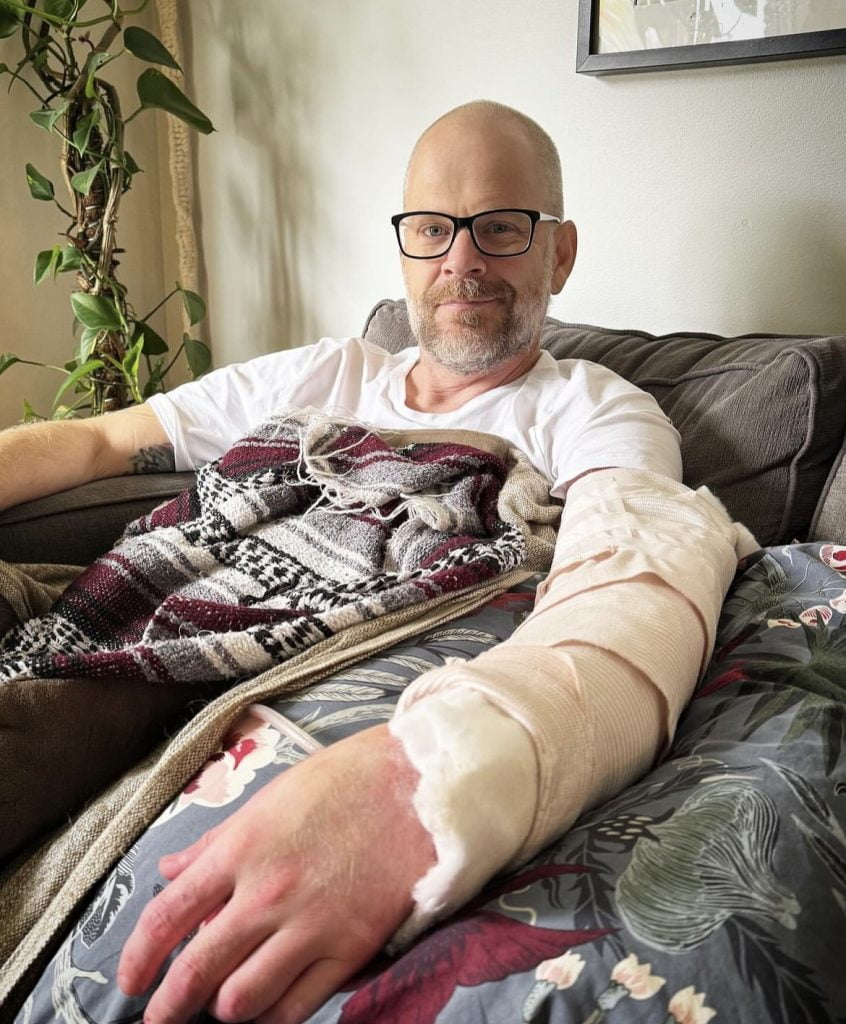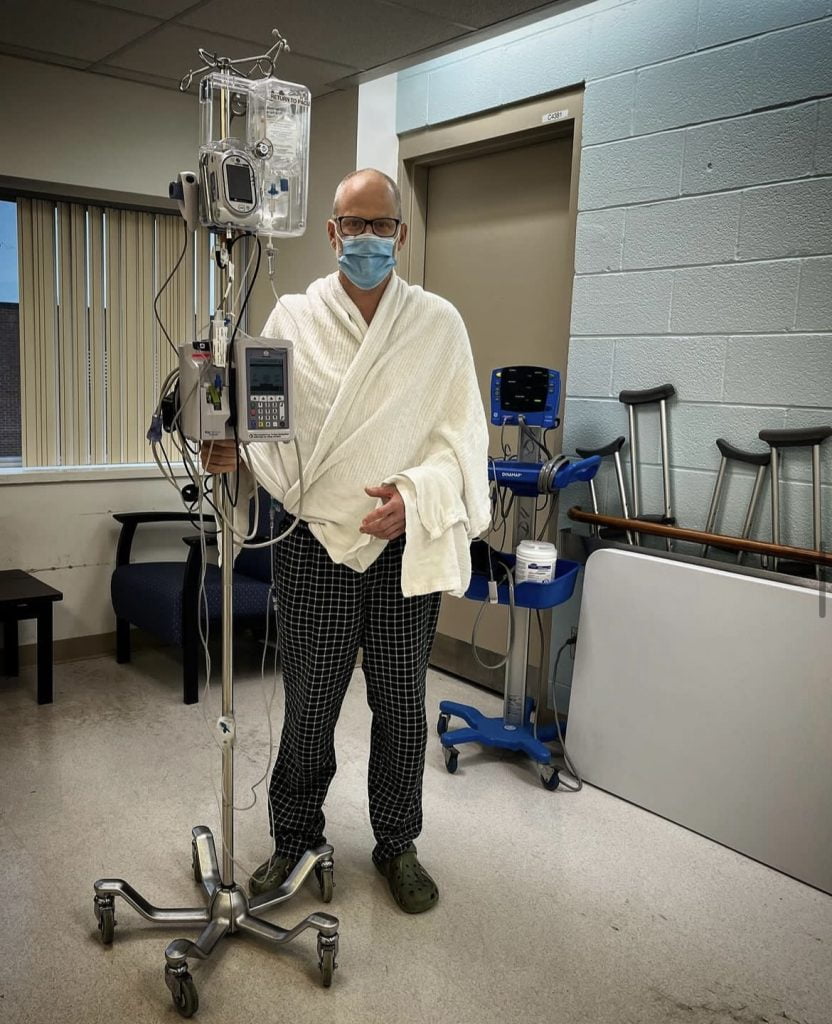
As Jeremy Sauvé was completing a volunteer project with his church, The Bridge, on September 4th, he had no idea that the experience was going to be life-changing.
The father of two was spending the morning helping with renovations to the Kanata Academy of Martial Arts – adding a refresh to the space by demoing an area of the club to expand mat space. They were about just completing the mornings project when, while carrying a section of wall, Jeremy accidentally cut himself on one of the drywall screws sticking out the back. The cut was on his left forearm – and it was deep. He was quickly rushed by ambulance to Queensway Carleton Hospital.
The wound was flushed with saline, and he was stitched up and sent home to recover – a routine visit for this type of injury. What happened next was anything but routine. In fact, it became a harrowing battle for his life.
“It wasn’t until the next day that something didn’t seem quite right. I began to feel unwell, eventually the pain was unbearable and my fever spiked to 106F in the span of 20 minutes.”

Without wasting any time, Jeremy was rushed back to QCH that evening by his wife, Amanda. As he was wheeled into the Emergency Department (ED) his fever had broken but his condition had worsened significantly. He was quickly triaged through the ED and the medical team suspected that an infection was the root cause. If this was the case, he would need to undergo surgery to repair the injury and confirm the infection. And it all had to happen STAT. Jeremy arrived at the QCH at 8:00 pm and by 11:30 PM was in surgery to attempt to discover what was the cause of his symptoms.
After the second, lengthy, surgery, two CT scans, and numerous lab tests the Infectious Disease team confirmed that Jeremy was suffering from a bacterial infection called Necrotizing Fasciitis, more commonly referred to as flesh-eating disease. This aggressive infection spreads rapidly through the body attacking soft tissue, including muscle, and without rapid intervention is fatal.
With the infection confirmed, the medical team were able to determine next steps in his treatment plan, which included the removal of the affected tissue to prevent the infection from spreading and massive doses of antibiotics. They had to move quickly to ensure that the infection wasn’t able to spread up his arm and into his chest.
Everything happened so fast and the whole situation brought tremendous uncertainty to Jeremy and his family. His story seems completely unbelievable. He went from a healthy individual to someone fighting for his life in less than 24 hours. He would never have thought a cut on his arm could lead to such a dire situation.
“When my surgeon and infectious diseases team came into my room, prior to my second surgery, and told me that the infection was so severe that amputation of my arm was a possibility, I was stunned,” shares Jeremy. “With my wife by my side I called my children immediately and told them that I loved them. I just didn’t know what was going to happen next, and if I was going to make it through. It was the hardest call of my life.”
Jeremy woke up the next day in the Intensive Care Unit (ICU) following his second surgery, and although he was not out of the woods yet, his surgeons, Dr. Sean Smith and Dr. Trefor Nodwell, were successful in removing the infected tissue. Now it was just a waiting game.
One week after he sustained the injury and following a third surgery to remove more tissue, Jeremy was finally transferred from the ICU into the post-surgical care unit.
There he was monitored closely by the QCH medical team as his white blood count remained high. The incision, which began as a four-inch laceration on his forearm, now stretched from his palm to his armpit. To ensure the wound healed without further infection Jeremy underwent frequent and excruciating painful dressing changes, several of which were demonstrated in front of a group of nursing students undertaking their placements at QCH.
“There are only 90 to 200 cases of Necrotizing Fasciitis every year in Canada, so I’m certain they will be walking away with a tremendous story!” Jeremy said, trying to find some levity even during the darkest of times.
After nearly 30 days since being admitted to the hospital Jeremy and his family received some welcome news – there were no more signs of infected tissue, and his white blood count was in check too. The following week, exactly one month after his initial visit to QCH’s Emergency Department, Jeremy was discharged from the hospital to continue his recovery from home.
Since then he has completed his course of antibiotics and underwent a skin graft surgery to begin the long journey towards healing. Soon he will begin physiotherapy to regain the function in his hand lost through the ordeal.
“There are no words that can fully express my gratitude for the incredible medical team at QCH. The care and empathy they showed me each day was world-class.”

“I’ve learned so much about caring for others from this experience and each function of the hospital team is a part of an incredible ecosystem that resulted in me being able to return home to my family. As a Pastor I will carry the lessons I have learned here with me forever as I endeavor to care for others. “We are so lucky to have QCH in our community,” shares Jeremy.
Generous donors of Queensway Carleton Hospital Foundation are the reason why our healthcare team can provide world-class care, close to home. Many people don’t know that government funding does not cover the costs for the purchase of life-saving medical equipment such as the CT Scanner, ultrasound, and surgical tools used to save Jeremy’s life. Without the quick action of the QCH team and the medical equipment used to diagnose and treat Jeremy, he would not be at home with his family today.
Jeremy is only one of the 500,000 individuals in our community who use the services of Queensway Carleton Hospital each year. And as our community continues to grow, so does the demand for essential services. With your support, QCH Foundation can invest in important enhancements to our hospital, which includes the purchase of new lifesaving technology and equipment.
